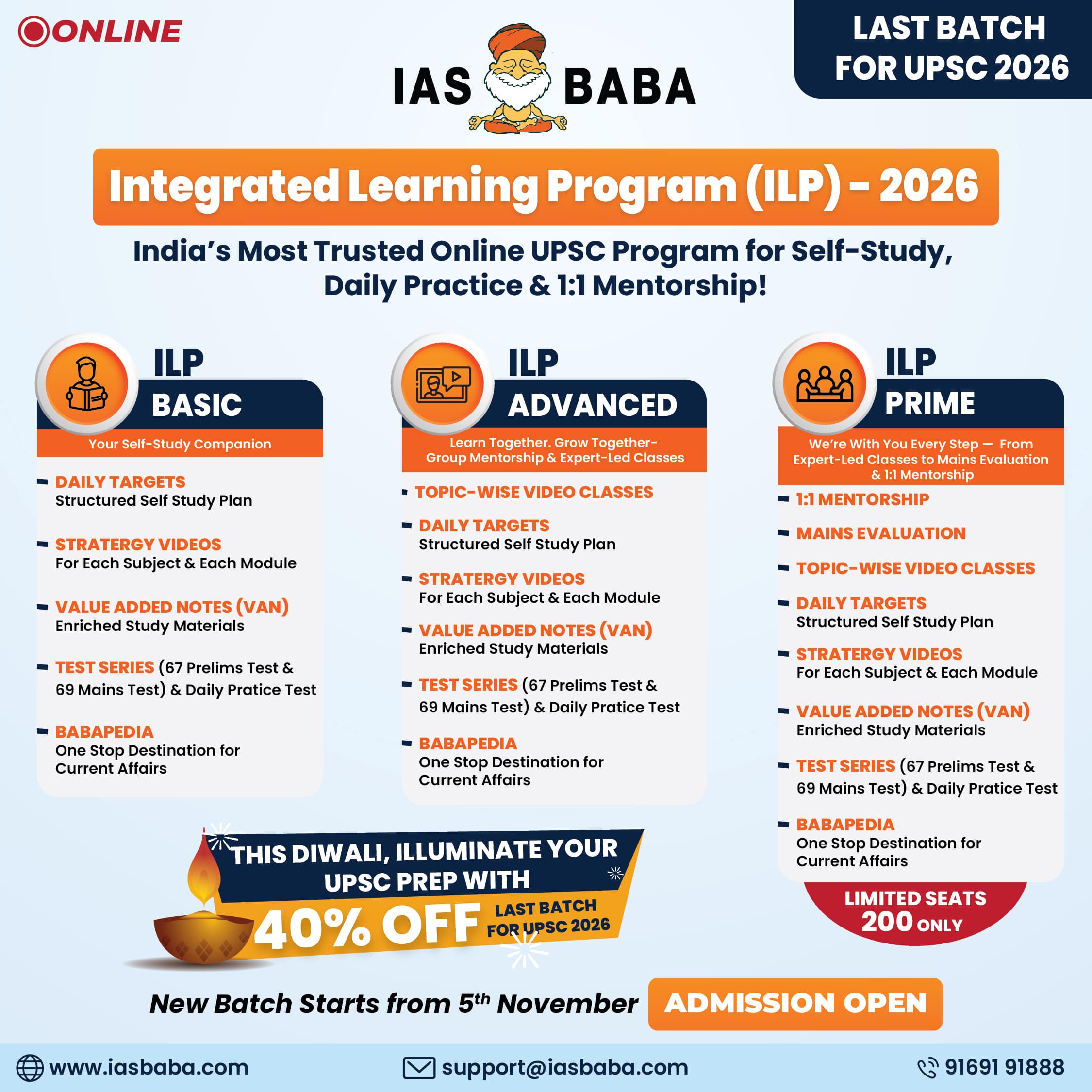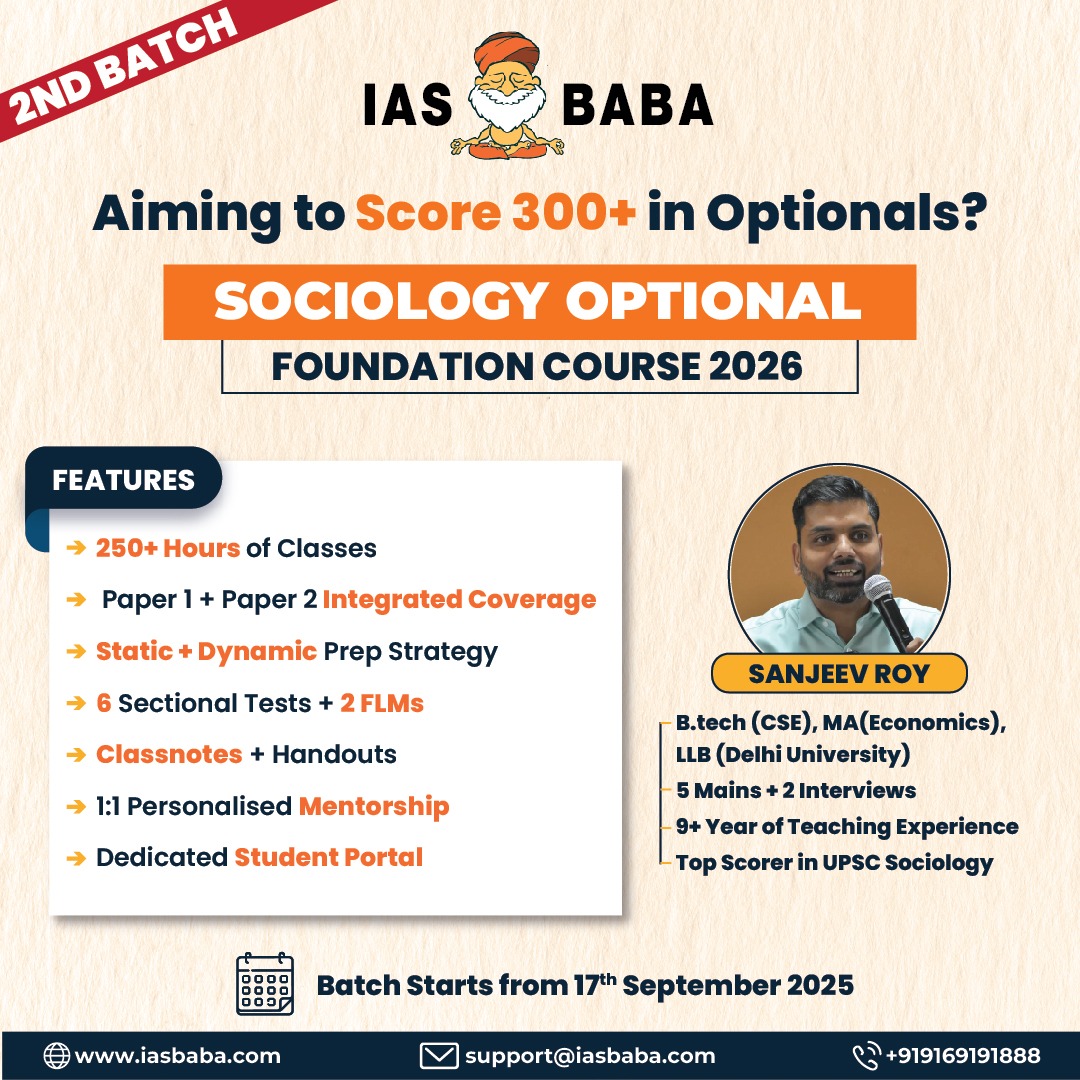IASbaba's Daily Current Affairs Analysis
rchives
(PRELIMS Focus)
Category: SCIENCE AND TECHNOLOGY
Context: Prime Minister Narendra Modi received the first Made in India Vikram 32-bit chip at Semicon India 2025, marking a milestone in the country’s semiconductor industry.
- The Vikram 32-bit Processor, an upgraded version of the earlier 16-bit VIKRAM1601 microprocessor, was developed by ISRO’s Vikram Sarabhai Space Centre and the Semiconductor Laboratory, Chandigarh. It has been used in ISRO’s launch vehicles since 2009 for space flight and avionics.
- Union Minister Ashwini Vaishnaw presented the chip to PM Modi, along with 31 prototype chips developed by IITs and NITs.
- India currently has five semiconductor units under construction, one pilot line completed, and two more units set to begin production soon.
- This achievement strengthens India’s position as an emerging semiconductor hub, boosting global confidence in its technology sector.
Learning Corner:
The Vikram 32-bit chip is India’s first indigenously developed 32-bit microprocessor for space applications. It is an advanced version of the earlier VIKRAM1601 (16-bit) processor and has been developed by ISRO’s Vikram Sarabhai Space Centre in collaboration with the Semiconductor Laboratory, Chandigarh.
The chip is specifically designed for space flight and avionics systems in ISRO’s launch vehicles and has been in operational use since 2009. Its development marks a major step in India’s semiconductor self-reliance, showcasing the country’s ability to design and manufacture high-end processors for critical sectors like space technology.
The presentation of this chip at Semicon India 2025 highlights India’s growing semiconductor ecosystem and its strategic push to become a global manufacturing hub.
Source: THE HINDU
Category: DEFENCE
Context : The 14th edition of the India-Thailand joint military exercise Maitree-XIV began on September 1, 2025, at the Joint Training Node in Umroi, Meghalaya
- Participants: 120 personnel from India’s Madras Regiment and 53 from Thailand’s 1st Infantry Battalion, 14th Infantry Brigade.
- Focus: Counter-terrorist operations in semi-urban terrain under UN Charter Chapter VII, including tactical drills, joint planning, special arms skills, fitness, and raiding operations.
- Significance: Strengthens defence ties, interoperability, and mutual trust, culminating in a 48-hour validation exercise simulating real-world scenarios.
- Background: Started in 2006, Exercise Maitree remains a key bilateral initiative enhancing defence cooperation and regional strategic partnership between India and Thailand.
Learning Corner:
Major military exercises of India
| Exercise | Partner / Participants | Type | Focus / Objective |
|---|---|---|---|
| Maitree | Thailand | Army | Counter-terrorism, semi-urban/jungle warfare, interoperability. |
| Garuda Shakti | Indonesia | Army (Special Forces) | Counter-insurgency, counter-terrorism, jungle survival. |
| Shakti | France | Army | Counter-terrorism in semi-urban and high-altitude conditions. |
| Surya Kiran | Nepal | Army | Counter-insurgency, disaster response, humanitarian assistance. |
| Nomadic Elephant | Mongolia | Army | Counter-insurgency, peacekeeping, and desert warfare. |
| Hand-in-Hand | China | Army | Counter-terrorism and humanitarian assistance under UN mandate. |
| Yudh Abhyas | USA | Army | Counter-insurgency, counter-terrorism, and peacekeeping operations. |
| Indra | Russia | Tri-services | Counter-terrorism, peacekeeping, and joint operations. |
| Sampriti | Bangladesh | Army | Counter-terrorism and disaster management. |
| Ajeya Warrior | United Kingdom | Army | Counter-terrorism and joint tactical operations. |
| Garuda | France | Air Force | Air-to-air combat, interoperability, strategic cooperation. |
| Cope India | USA | Air Force | Air combat tactics, strategic airlift, and joint operations. |
| Indo-Russian Avia Indra | Russia | Air Force | Air defence, ground attack coordination. |
| Varuna | France | Navy | Maritime security, anti-submarine warfare, and interoperability. |
| Malabar | USA, Japan, Australia | Navy (Quadrilateral) | Maritime security, freedom of navigation, and Indo-Pacific cooperation. |
| JIMEX | Japan | Navy | Maritime security, anti-submarine warfare, and joint tactical manoeuvres. |
| Simbex | Singapore | Navy | Anti-submarine warfare, maritime security, and sea control operations. |
| Konkan | United Kingdom | Navy | Maritime security, anti-piracy, and naval cooperation. |
| MILAN | Multinational (Indian Ocean, Indo-Pacific) | Navy (Multilateral) | Maritime cooperation, interoperability, and regional security. |
Source: PIB
Category: ECONOMICS
Context: APEDA has launched the BHARATI initiative (Bharat’s Hub for Agritech, Resilience, Advancement and Incubation for Export Enablement) to accelerate India’s agri-food exports
- Focus: Promoting innovation, incubation, and export opportunities in GI-tagged products, organic foods, superfoods, livestock, and AYUSH items.
- Features: A three-month acceleration programme covering product development, export readiness, market access, regulatory compliance, and solutions for perishability, logistics, and value addition.
- Technology: Integration of AI-based quality control, blockchain traceability, IoT-enabled cold chains, agri-fintech, and sustainable packaging.
- Impact: Nationwide awareness campaigns and a scalable incubation model to boost India’s global standing in agri-food exports through technology and entrepreneurship.
Source: PIB
Category: ECONOMICS
Context Bond yields in India have risen despite RBI’s rate cuts due to structural and market factors that outweigh policy easing.
- Heavy Government Borrowing: The 2025–26 Budget projects net borrowing of ₹11.55 lakh crore, creating oversupply of bonds and pushing yields higher.
- Fiscal Concerns: Rising debt (₹17.55 lakh crore in March 2025, projected to ₹19.01 lakh crore in March 2026) and deficit worries make investors demand higher returns.
- Liquidity Management: RBI injected liquidity but absorbed it through Variable Rate Reverse Repo (VRRR) auctions, sending mixed signals and limiting the effect of rate cuts.
- Weak Demand & Global Factors: Banks, insurers, and foreign investors have shown lower appetite, while global bond yields remain elevated.
- Risk Premium: Despite low inflation (below 2% in July 2025), investors seek a premium amid fiscal and global uncertainties. The yield–repo spread has widened to around 100 basis points, the largest in 2025.
Learning Corner:
Relation between bond yields and rate cuts:
Normal Case – When Rate Cuts Lower Yields
- Suppose RBI’s repo rate is 6%, and the government issues a 10-year bond with a coupon (interest) of 7%.
- If RBI cuts the repo rate to 5%, new loans and bonds will generally offer lower returns (closer to 5–6%).
- Investors now rush to buy the older bond paying 7%, raising its price.
- Since Yield = (Coupon ÷ Price) × 100, higher price → lower yield.
- Example: Bond with ₹1,000 face value paying ₹70 annually (7%).
- If demand pushes its price to ₹1,100 → Yield = 70 ÷ 1100 = 6.36% (lower than before).
Exceptional Case – Why Yields May Rise Despite Rate Cuts
- RBI again cuts repo rate from 6% → 5%.
- But suppose the government announces huge borrowing (₹11.5 lakh crore). That means more bonds will be supplied in the market.
- Investors worry about fiscal deficit and demand higher return to hold these extra bonds.
- Even though RBI cut rates, bond prices may fall due to oversupply and risk concerns.
- Example: Same bond (₹1,000 face value, paying ₹70). If price falls to ₹950 → Yield = 70 ÷ 950 = 7.36% (higher than before).
Source: THE INDIAN EXPRESS
Category: POLITY
Context: India’s first AI-powered translator for tribal languages
- Launched by the Ministry of Tribal Affairs as part of Janjatiya Gaurav Varsh celebrations.
- India’s first AI-powered translator for tribal languages.
Key Features:
- Developed by a consortium led by IIT Delhi with BITS Pilani, IIIT Hyderabad, IIIT Nava Raipur, and Tribal Research Institutes.
- Beta version supports Santali, Bhili, Mundari, and Gondi, with Kui and Garo under development.
- Provides real-time text and speech translation with Hindi/English, interactive learning modules, digitization of folklore, and subtitled advisories.
Objectives & Impact:
- Preserves and revitalizes endangered tribal languages.
- Bridges communication gaps between tribal and non-tribal communities.
- Enhances digital literacy, access to education, healthcare, and governance.
- Strengthens cultural diversity and inclusion through technology.
Access:
- Available via web platform, with mobile app versions coming soon.
Learning Corner:
Tribal Languages in the Eighth Schedule
The Eighth Schedule of the Constitution lists 22 official languages. Among them, some are tribal in origin or largely spoken by Scheduled Tribe communities:
- Santali – Added by the 92nd Constitutional Amendment (2003); spoken mainly in Jharkhand, Odisha, West Bengal, Bihar; uses Ol Chiki script.
- Bodo – Added by the 92nd Amendment (2003); spoken in Assam, linked to Bodo-Kachari tribal groups.
- Manipuri (Meitei) – Added by the 71st Amendment (1992); spoken in Manipur, predominantly by Meitei but also linked with tribal sub-groups in the region.
Source: PIB
(MAINS Focus)
Introduction (Context)
With the retirement of Justice Sudhanshu Dhulia (August 2025), two vacancies arose in the Supreme Court.
Despite this opportunity, no women were appointed. Justice B.V. Nagarathna remains the only woman judge in a sanctioned strength of 34 judges.
Since independence, women’s representation in the Supreme Court has been negligible, raising concerns about diversity, inclusivity, and fairness in the judicial system.
Data
- Since its inception (1950), only 11 women judges have been appointed to the Supreme Court, i.e., a mere 3.8% of the 287 judges.
- Justice Fatima Beevi (October 6, 1989-April 29, 1992) was the first female judge of the Supreme court
- The appointment of three women judges in August 2021 under CJI N.V. Ramana was unprecedented. For the first time, women’s representation crossed 10% in the Court.
- Caste and community diversity is absent; no woman from SC/ST has ever been appointed, and Justice Fathima Beevi remains the only woman from a minority faith.
- Direct appointments from the Bar show stark gender disparity: nine men vs. only one woman (Justice Indu Malhotra). Despite capable women Senior Advocates, no further elevation has taken place.
- Women are often appointed at a later age, resulting in shorter tenures, limited chances in the Collegium, and rare opportunities to become CJI.
- The first woman CJI, Justice B.V. Nagarathna, will hold office only for 36 days (Sept–Oct 2027), reflecting systemic barriers.
Appointment Procedure of judges
- As per the Memorandum of Procedure, a Supreme Court judge is appointed by the President based on recommendations of the Collegium, comprising the Chief Justice of India (CJI) and the four seniormost judges.
- The recommendation is sent by the CJI to the Union Law Minister, who forwards it to the Prime Minister, and finally to the President of India for approval.
Issues
- Criteria for selection are not public; Collegium resolutions are inconsistent in disclosing reasons. Secrecy around who is being considered and when undermines accountability.
- Gender is not taken into consideration for appointments of judges to the Supreme Court and High Courts.
- Seniority is applied inconsistently, with senior women judges often overlooked.
- No systematic effort to appoint women judges, either from High Courts or directly from the Bar. Since 2018 (Justice Indu Malhotra), no woman lawyer has been elevated directly from practice.
- While the Supreme Court has directed Bar Associations to reserve 30% seats for women, it has no mandate for its own gender representation.
Way forward
- Make gender, caste, religion, and regional representation part of a formal written policy for higher judiciary appointments.
- Gender must be recognised as a criterion in the Memorandum of Procedure.
- Collegium must publish criteria and reasons for every appointment.
- Appointments must be based on intellectual ability, sound judgment, and sensitivity to diverse social realities, alongside diversity commitments.
- Encourage direct elevation of women lawyers from the Bar to address historical exclusion.
- Ensuring timely elevation of women High Court judges to provide them sufficient tenure for leadership roles.
- Representation must not remain confined to urban, upper-caste women judges. Broader inclusivity will enhance legitimacy and representativeness of the judiciary.
Conclusion
Women judges make the Supreme Court fairer and representative. Their presence brings new perspectives, builds public trust, and strengthens justice.
True gender equality in India’s top court will be achieved only when more women are given space on the Bench.
Mains Practice Question
Q Despite progressive jurisprudence on gender equality, the representation of women in India’s higher judiciary remains abysmally low. Critically examine the causes and suggest institutional reforms to ensure gender inclusivity in the Supreme Court and High Courts. (250 words, 15 marks)
Source: India needs more women judges in the Supreme Court – The Hindu
Introduction (Context)
Semiconductors are the backbone of the digital economy, powering everything from smartphones and satellites to defence systems and artificial intelligence.
The COVID-19 pandemic exposed the vulnerabilities of global chip supply chains, underscoring their strategic importance.
India must work to improve the semiconductor industry to maintain the supply chain.
Why Semiconductors Matter for India
- Dependence on foreign chips leaves India vulnerable in critical areas such as healthcare, defence, and communication. Indigenous capability ensures sovereignty in technology and security.
- With electronics manufacturing crossing ₹12 lakh crore annually and over 65 crore smartphone users, India’s demand for chips is surging. This presents both an opportunity and a compulsion to develop domestic capacity.
- Semiconductor manufacturing is concentrated in a few regions (Taiwan, South Korea, US). Even small disruptions can halt global production. Semiconductors now lie at the heart of global geopolitics.
Steps taken by the government
Unlike countries such as Taiwan, South Korea, or the US, India had not been able to set up large-scale semiconductor fabrication plants (fabs). However, recently government has taken steps to improve the semiconductor industry in India.
Some are discussed below:
India Semiconductor Mission
- The India Semiconductor Mission (ISM), launched in 2021 under MeitY, to develop India as a global hub for semiconductor and display manufacturing.
- It supports setting up fabs, design-linked incentives, ATMP units, and skill development.
- Under this, the government approved the setting up of 10 semiconductor fabrication plants across the country. Work on these plants has already started.
- In Sanand, Gujarat, pilot production has begun, and the first “Made in India” chip is expected this year.
- ISM aims to reduce import dependence, boost innovation, and secure India’s digital and strategic future.
Global Investment and Ecosystem Building
- Making semiconductors is not just about building one factory. It requires a whole ecosystem — suppliers, equipment makers, raw material providers, logistics, and R&D support. Recognising this, many global leaders are investing in India.
- Applied Materials, Lam Research, Merck, and Linde are setting up factories and support systems
- This ecosystem approach will makes India’s semiconductor journey sustainable.
Workforce
- India already contributes to 20% of the world’s semiconductor design workforce. This is a huge advantage because:
- The world is expected to face a shortage of over 1 million semiconductor professionals by 2030.
- India is well placed to fill this gap, thanks to its large pool of skilled engineers.
Training and Tools
- To prepare the next generation of chip designers, the government is giving free access to world-class Electronic Design Automation (EDA) tools to 350 institutions and start-ups.
- In 2025 alone, these tools were used for 1.2 crore design hours
- This shows how India is equipping its young workforce with the latest technologies.
Start-up ecosystem
- Start-ups are emerging as important players in the semiconductor field. Example: Mindgrove Technologies is building IoT chips using IIT Madras’ indigenous SHAKTI processor.
- These start-ups, supported by the Design Linked Incentive (DLI) Scheme, are driving innovation and creating confidence among investors.
Terminologies
- Design Linked Incentive (DLI) Scheme: A government scheme to promote semiconductor chip design in India by providing financial and infrastructural support to start-ups, MSMEs, and academic institutions. It encourages innovation and reduces dependence on imported designs.
- Electronic Design Automation (EDA): EDA refers to specialized software tools used to design, simulate, and test semiconductor chips before actual manufacturing. These tools help engineers create efficient, error-free, and complex chip designs virtually.
Challenges
- Setting up a fab requires $5–10 billion investment, making financing difficult.
- Dependence on imports of rare earths, silicon wafers, and specialty gases makes India vulnerable
- Absence of strong supply chains for chemicals, gases, and equipment.
- Despite a strong design workforce, India lacks experienced professionals in chip fabrication and equipment handling.
Steps needed
- Move from pilot fabs to mass production and develop economies of scale.
- Focus on indigenous technologies, advanced nodes, and collaborative research.
- Reduce import dependence in critical raw materials through global partnerships and strategic reserves.
- Create specialised semiconductor engineering programs and industry-academia linkages.
- Involve global majors while nurturing local start-ups and MSMEs.
- Deepen cooperation with Quad, EU, Japan, and South Korea for technology and resilience.
- Ensure long-term incentives, infrastructure support, and investor confidence.
Conclusion
Semiconductors are the backbone of the digital age, much like steel was for the industrial era.
India’s push in this sector marks a transition from dependence to self-reliance, backed by policy support, global partnerships, and a strong talent base.
Despite challenges of high costs, technology gaps, and supply chain vulnerabilities, sustained efforts can make India a trusted hub in the global semiconductor value chain and secure its digital future.
Mains Practice Question
Q Semiconductors are the steel of the digital era.” In this context, critically analyse India’s efforts to build a self-reliant semiconductor ecosystem. What challenges does India face, and how can they be addressed? (250 words, 15 marks)














